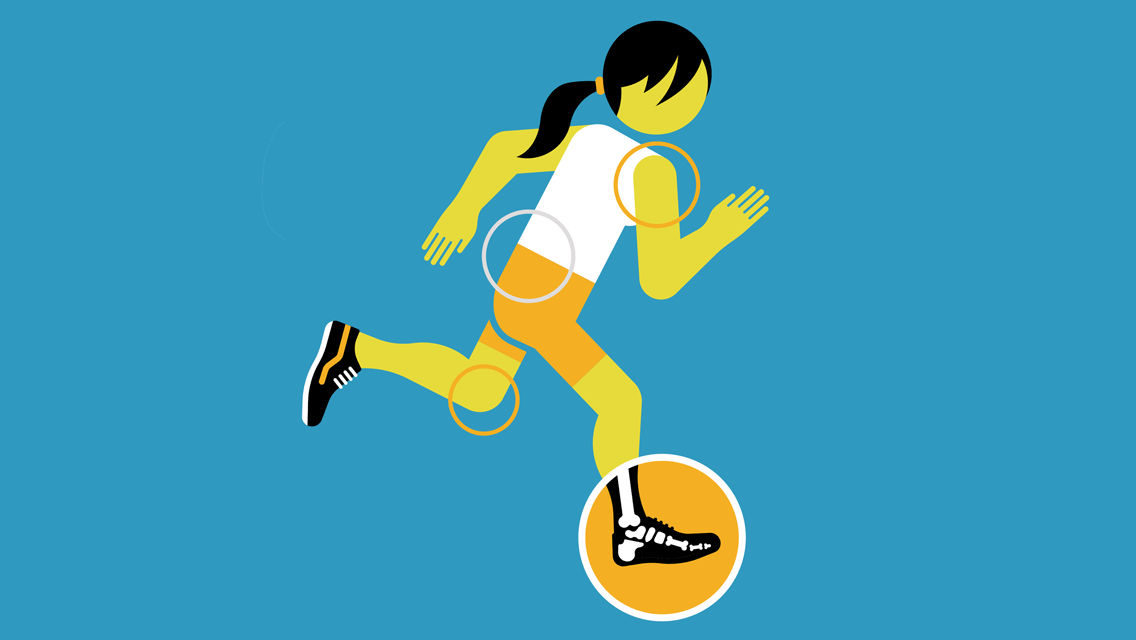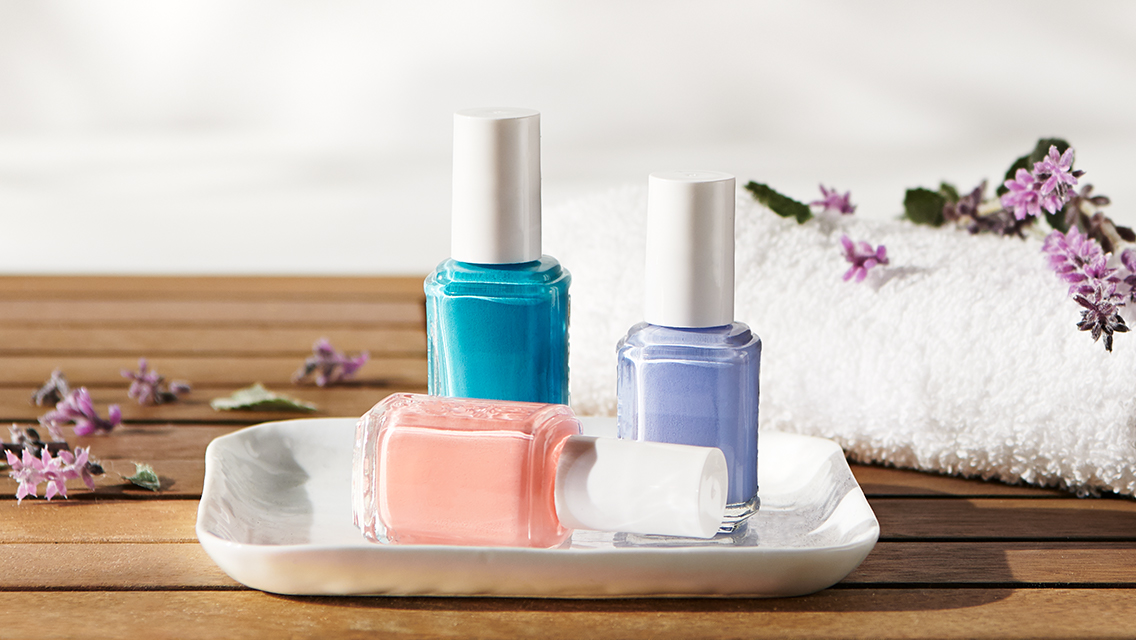Explore this article:
Stiffness • Toe Pain • Heel Pain • Numbness and Tingling • Swelling • Skin Concerns
As the literal foundation of our bodies, our feet are crucial to keeping us active and healthy. It’s easy to take these workhorse appendages for granted, but when problems arise, the ripple effects make the feet hard to ignore.
“When something goes wrong in your foot, your whole body usually has to deal with it,” says biomechanist Katy Bowman, MS, author of Simple Steps to Foot Pain Relief. Even a small area of soreness or irritation can be enough to keep you from your daily walk or cause other body parts to compensate in ways that lead to further issues.
“The average person takes thousands of steps every day, and if there’s something a little bit off in the biomechanics — meaning the structure or function of the foot — it won’t just affect the foot; it’s going to have a domino effect all the way up the body,” notes Robert Kornfeld, DPM, a holistic podiatrist at the Chronic Foot Pain Center in New York City. The reverse is also true: It’s not uncommon for knee, hip, and back pain to resolve after foot issues are addressed.
Many of us are unaware that the feet can be harbingers of systemic health problems. “The foot is a mirror of what’s going on in the rest of the body. Podiatrists are often the first ones to diagnose vascular and neurological problems, thyroid conditions, and diabetes,” Kornfeld says.
Let’s delve into six common foot complaints and the systemic issues they may be signaling, plus strategies for addressing them.
1) Stiffness
Possible causes: Inactivity, inflammation from arthritis, constrictive shoes
The main contributor to stiff feet also leads to inflexible shoulders and hips — lack of regular and thorough movement. “Even though the foot is small, it has a large number of hinges, and each of those hinges needs to be moved,” Bowman says.
Sitting for hours is surprisingly hard on the feet. “Inactivity, which tightens the hips and pelvis, can then tighten the feet, because your feet and hips are very much connected,” says Emily Splichal, DPM, a functional podiatrist at the Center for Functional and Regenerative Podiatric Medicine in Chandler, Ariz.
Systemic inflammation, often a feature of arthritis, also contributes to stiff feet. “Inflammation can be thought of as stickiness — it causes a lot of soft-tissue adhesions,” says Splichal. Regular movement reduces stickiness and keeps the joints of the lower body strong and flexible.
Footwear is another important player. “Most of the time, our feet are wrapped in something very stiff that immobilizes their parts,” Bowman notes. Imagine wearing tight, rigid mittens on your hands every day: Your wrists and forearms would compensate as you learned to use each hand as a single digit, losing the muscular control and flexibility to separate them into their constituent parts. This is essentially what modern footwear has done to our feet.
“Compared with our feet’s natural, unshod state, our shoes are stiff, usually prop our heels above our toes, and leave no room for our toes to move,” Bowman says. This leads to weak, underdeveloped foot muscles and puts stress on the lower leg, as well as on the joints, fascia, and ligaments in the feet.
“Our feet, in shoes and on flat concrete, are sort of like our digestion on a crappy diet — they’re starved of the nutritious movement inputs they need for health,” she notes.
Foot arches that are either flat and weak or high and tight are also a sign of inflexibility. Bowman describes the arch as an action by the muscles in the feet and hips. A flat foot indicates a lack of the strength needed to create an arch, while high, inflexible arches can point to excessive tension.
Either can stop the midfoot from stretching out and springing back up again to cushion our steps. And both can be helped with exercises to build strength and flexibility in the feet. (For feet-strengthening exercises, see “Strength Training for Your Feet.”)
2) Toe Pain
Possible causes: Gout, bunions, ingrown toenails
When you think “toe pain,” diet might not be the first culprit that springs to mind. But diet-related gout, an inflammatory condition that causes swelling and pain in the joints, often shows up first in the foot. “It’s a red, hot, inflamed big-toe joint where even the blankets on your bed are enough to cause pain,” Splichal explains.
Gout can have a genetic component, but diet is usually the biggest contributing factor. Red meat, seafood, sweetened drinks, and alcohol all contain high levels of compounds called purines, which the body breaks down into uric acid. These acid crystals can accumulate in the joints, leading to pain and inflammation. Dietary changes are the first line of defense here. (For more on uric acid, see “Uric Acid: A New Metric for Heart Health.”)
On the other hand, a bunion — which appears as a bony bump on the joint at the base of the big toe — is usually a “purely biomechanical issue,” Kornfeld says. Bunions can form due to gait patterns, instability in the first metatarsal (the bone extending toward your ankle from the big toe), and overpronation, and they are exacerbated by narrow shoes that force the big toe toward the pinky. They tend to occur more frequently in women and older people, possibly due to relatively weaker connective tissue and the cumulative effects of biomechanical dysfunction.
If the ligament holding the first metatarsal is loose or unstable (possibly from insufficient collagen, which stabilizes ligaments), it can cause retrograde forces to push the bone out to form a bunion. But corrective exercises can improve joint stability, even in people with a genetic tendency toward lower collagen levels.
And minimizing time in high heels, which put the body’s weight right over the big-toe joint, can be preventive. “Intervention is critical in the early stages of bunion formation so it doesn’t progress into a deformity that creates problems wearing shoes, causes pain, and limits activity,” Kornfeld says.
Ingrown toenails, in which the borders of the nail turn downward and dig into the skin, are a common cause of toe inflammation, redness, swelling, and pain. Again, tight shoes can be to blame, Splichal explains. “If your shoes are pushing the edge of the nail into the skin, that could contribute to an ingrown nail.”
Bunions can be a factor here, too, because of how they change the angulation of the step and push the nail into the skin. And cutting toenail corners too aggressively allows the skin to lift above the nail border, so the nail grows into the skin. Podiatrists recommend cutting toenails straight across to avoid this.
“I’d also encourage a patient to use toe spacers if they have a bunion, find better-fitting shoes that don’t push the nail in, and possibly put urea on the nail to soften it so it’s not so hard and painful,” says Splichal.
3) Heel Pain
Possible cause: Plantar fasciitis
Plantar fasciitis is inflammation of the thick band of fascia that runs from the heel bone to the toes. It can be caused by a one-time event in which you overload the tissue, such as walking for miles on vacation in new shoes. Or it can develop over a longer period in response to posture or mobility issues in the feet, says Bowman.
“Plantar fasciitis is biomechanical in origin,” Kornfeld explains. “One typical cause comes from the calf muscle being overly tight in compensation for hypermobility in the forefoot. The tighter the calf muscle gets, the greater the pull and stress on the plantar fascia, which can injure cells and cause them to become chronically inflamed.” Small tears may also develop in the plantar fascia, adding to pain and inflammation.
The antidote, says Bowman, is mobilizing and stretching the foot. “You’ve got this stiff, tense wad of injured tissue, and you want to stretch and smooth it out like a ball of dough.” She suggests using targeted stretches and rolling the foot out on a ball. “These are ways of waking up this tissue that’s clumped to protect itself.”
Other strategies include getting a biomechanical evaluation to help identify problematic gait and posture habits, changing your footwear, and trying acupuncture.
While some may benefit from taping or using an orthotic or brace, Bowman stresses the importance of identifying the underlying cause. “You want to get your foot working better for you without all that gear, or else you’re not really getting to the root of the problem.”
(Learn how to tame the pain of plantar fasciitis at “Natural Strategies and 3 Gentle Exercises to Alleviate Heel Pain.”)
4) Numbness and Tingling
Possible cause: Peripheral neuropathy
When nerves in the hands and feet are damaged, peripheral neuropathy can result. Symptoms include numbness, tingling, loss of balance, weakness, or a wound on the foot that won’t heal.
Diabetes (both type 1 and type 2) is the most common trigger: High blood-sugar levels can damage nerves over time. Other potential causes include vitamin B12 deficiency, physical injury to the nerves, chemotherapy, medication side effects, drinking too much alcohol, or viral illness.
“I have quite a few patients who developed post-COVID peripheral-nerve inflammation and symptoms,” notes Splichal. Shingles is also known to be a potential trigger for neuropathic pain or numbness. Lupus, rheumatoid arthritis, and other autoimmune conditions can contribute by creating inflammation in peripheral nerves.
Key to relief from all these conditions is reducing that inflammation. Splichal recommends an anti-inflammatory diet that supports stable blood sugar, nutrient balance, and microcirculation. “All of our blood vessels have tiny branches that go to the nerves, so you need to think of microcirculation to support nerve health,” she says.
Splichal also treats her neuropathy patients with red-light therapy. And some people find transcutaneous electrical nerve stimulation (TENS) and acupuncture helpful.
5) Swelling
Possible cause: Fluid retention
Swollen feet and ankles may be related to edema, when too much fluid becomes trapped in the body’s tissues. Edema can be caused by poor venous return (when the body’s ability to pump blood up and away from the feet is compromised), eating too much salt, being pregnant, being premenstrual, or sitting or standing in place for too long.
It may also be a side effect of certain medications or a sign of insulin resistance. “Uncontrolled blood sugar creates free radicals and inflammation that damages collagen in the blood vessels, so they start to lose integrity,” Splichal says.
Edema can signal even more serious conditions, including problems with the kidneys, liver, or heart. If you have persistent swelling in your feet and ankles, it’s wise to check with your healthcare provider.
Whatever the underlying issue, swelling in the feet and ankles is usually relieved by elevating them. And while taking a walk can sometimes increase swelling (especially in hot weather), walking provides a net benefit. The calves are known as the “second heart” because of the role they play in pumping blood through the lower part of the body.
“The feet, being farthest away from the heart, run the greatest risk of poor circulation; your cardiovascular system depends heavily on the movement of the muscles in the feet and lower legs,” writes Bowman in Simple Steps to Foot Pain Relief.
The best way to lend the heart a hand is to get moving. “You need a pumping mechanism to get the blood back up to the heart, and walking is a great way to activate that calf pump,” Splichal explains. (For more on your calves and cardiovascular health, see “The Surprising Connection Between Your Calves and Heart Health.“)
6) Skin Concerns
Possible causes: Plantar warts, fungal infections, gut dysbiosis, thyroid issues
Our feet are subject to lots of rubbing, friction, and contact with moist environments, from the insides of our socks to the shower floor at the gym. While blisters and calluses can be handled with a little TLC and a change of shoes, warts and persistent fungal infections are tougher nuts to crack.
“Plantar warts are associated with the human papillomavirus [HPV],” Splichal notes. Genetics and overall immune status can affect how well someone fights HPV. Some may develop small warts that self-resolve, while others end up in long battles with warts that refuse to disappear.
“Warts like dark, wet environments,” she says. “If you’re keeping your feet in socks for 10 hours a day, that’s a perfect breeding environment.” She suggests exposing your feet to open air as much as possible to dry them out.
Splichal also cautions against picking at a plantar wart, because they can spread to your hands or your other foot.
For small warts, applying a topical salicylic acid might do the trick, she notes. “But when they get larger, you want to go to a podiatrist or dermatologist so they can freeze or burn it off.”
Meanwhile, dry, itchy skin on the feet usually signals fungal infection. Fungus can infect the nails, the skin between the toes, or the bottom of the foot. “They’re all treated a little bit differently,” Splichal says.
An infection under the nail might require oral medications. “If you just put something topical on, it’s hard for the medication to get through the hard nail to reach it.”
Treating a fungal infection that starts between the toes and spreads, such as athlete’s foot, requires keeping moisture-prone areas dry. These infections can usually be treated with antifungal creams or sprays. Tea tree oil is a natural antifungal treatment for athlete’s foot.
Some providers see fungal infections on the feet as a sign of gut dysbiosis and an excess of fungus in the GI tract. “When we address what’s going on at a gut level, we have a much better opportunity to get rid of it,” Kornfeld notes.
Finally, itchy feet can occasionally signal a problem with the thyroid. “Thyroid dysfunction causes problems [with] replenishing and replacing skin cells,” he explains. That can lead to dry and dead cells accumulating on the surface of the skin, causing itchiness.
Find Your Stride
Noting that prevention is the best cure of all, Splichal offers these four tips for daily foot maintenance:
- Release tension in the feet with active stretches or massage.
- Activate the muscles with simple exercises.
- Engage the foot muscles and create stability with single-leg balancing for 10 seconds on each side.
- Stimulate sensation by spending time barefoot.
Bowman reminds us that our feet deserve at least as much attention as our other body parts. “If you do pull-ups or upper-body exercises, make sure you’re giving your feet the same courtesy. You’re going to ask more from your feet than you are from your arms and shoulders throughout your lifetime.”
Why Go Barefoot?
To develop strong muscles, dense bones, and healthy nerves, our feet need to be worked just like other body parts. That’s why some podiatrists recommend spending as much time as possible barefoot — or in minimalist footwear that protects the skin and allows the foot its full range of motion.
“Tissue needs to feel load in order to adapt,” explains biomechanist Katy Bowman, MS, author of Rethink Your Position. “If you’ve cushioned and immobilized your feet with rigid shoes, they no longer feel load. So, you’re putting the weakest part of you underneath your entire body weight.”
Still, don’t just chuck your Chucks and head out for a barefoot sprint. “There’s a lot of transitional work needed if you’ve been wearing shoes for decades,” she cautions. “Exercises and awareness can help you transition successfully.” (For more on barefoot training, see “Bare Your Sole: Barefoot Training.”)





This Post Has 0 Comments